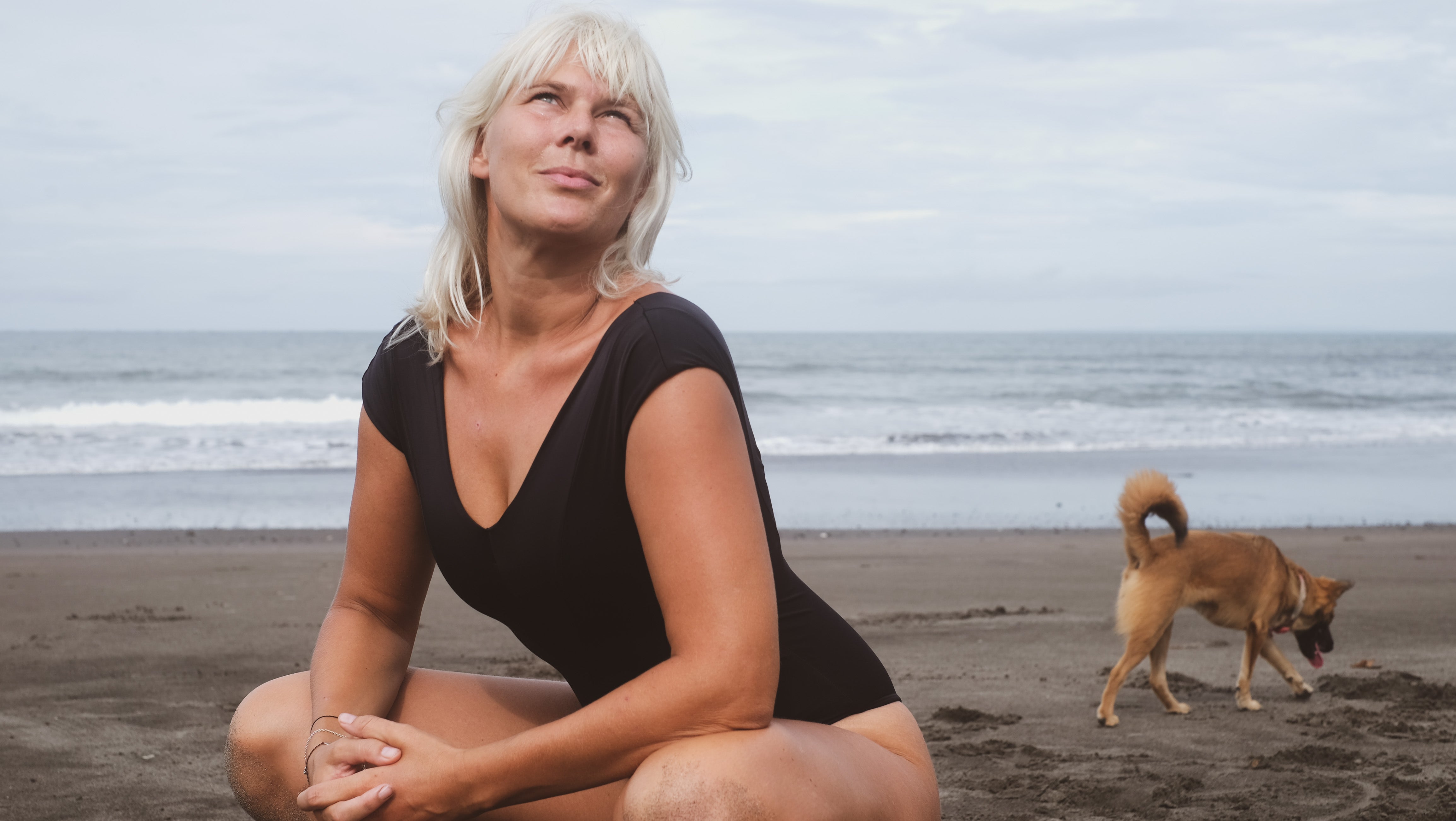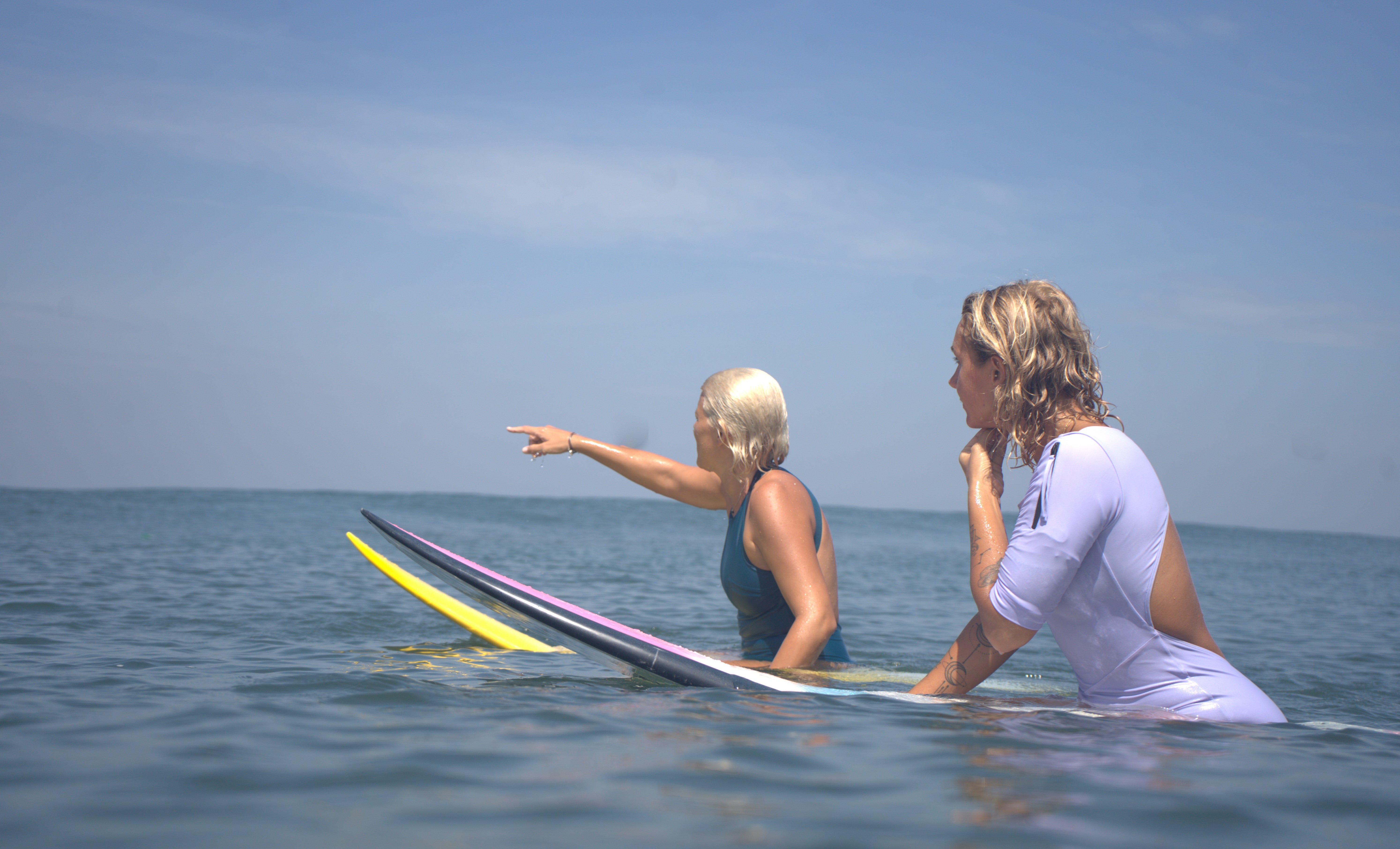Surf Psychology: How to overcome your fear of big waves
We want to share with you this amazing and very educational article that our surf mate Lisa wrote out of her professional experience. The apprehension and the fear in the water are experienced by every surfer at some point naturally. That is why we would love to share more about this topic and bring some clarity and maybe advice for those who might find themselves in such a situation while in the ocean. Let us introduce the author first.

Photo of Lisa wearing the ninefoot Dreamland one piece in black
Source: ninefoot studio
***CLICK ON THE PHOTO TO SEE THE PRODUCT DETAILS
Lisa is a psychologist and a hypnotherapist from Sweden. She moved to Bali in 2016 to pursue surfing and to build her own business. Lisa built and now runs a thriving retreat and boutique surf hotel business in southwest Bali called Coconut Corner. It’s a beautiful green and natural space just 300 m from the beach. It’s the perfect place to go and disconnect from a hectic modern life and to focus on surfing and self-development.
If you are intrigued about her work in surf psychology, her business offers surf psychology retreats for small groups as well as custom private retreats. Visit the website www.coconutcornerbali.com/retreats for more information. You can also follow her on Instagram @surfpsychologybylisa

Lisa´s retreat in the heart of Bali
Source: @surfpsychologybylisa
Let´s get into Surf psychology…
First of all, some fear of big waves is healthy. We all know that bigger waves come with more power and hence higher risks. It’s being close to that risk and that danger that releases adrenaline and dopamine in your system, and it is a part of the reward cycle around surfing.
I.e., why we love it in the first place. It’s when the size of the wave generates a fear response instead of just adrenaline and dopamine that it becomes uncomfortable and sometimes debilitating. And when that fear then occurs in a situation where your conscious mind knows you are perfectly safe, it ruins the fun in surfing. This is the fear we want to get rid of. Not the one that is healthy and keeps us out of situations that are beyond our skill. A continued fear response when surfing will usually lead to avoidance of conditions that elicit the response and will ultimately keep you from freely enjoying surfing. Perhaps it might even put you off surfing altogether.

Lisa heading to the water with her client. Both wearing the ninefoot studio swimsuits Guadalupe and Canggu one pieces
Source: @surfpsychologybylisa
I am here to tell you that (a) you are not the only one who suffers from this, a lot of surfers do, and (b) it’s possible to get over it. Before I tell you how to get over it, I will explain to you how and why this is happening.
How the mind works with fear, during a surf session
For everyone, or at least everyone I have met and worked with so far, it starts with one or a few compiling adverse experiences in the water. For many it’s while surfing but it doesn’t have to be. It might not even have happened in the water. In this article I will stick to surf related scenarios but the process is much the same whether you are on a board or not.
What has happened is that you have been in a situation that resulted in your nervous system getting overwhelmed. What I mean by this is that you have gone from being in a fight or flight mode to a fright mode. The fight or flight mode is still a functional or active state of your nervous system where more blood is pumping to your muscles, quicker breathing, release of blood sugar to provide energy for your muscles etc. This state is initiated by adrenaline being released into your bloodstream.
This is all to make your body hyper alert and able to quickly act. The fright mode however is not very functional. Neither are the following flags and faint modes that follow in this model. These states are classified as dissociative states where thinking becomes difficult, and emotions are running high. However, these states are not of interest for the scope of this article.

Lisa pointing on the wave and encouraging her client to overcome her fear
***CLICK ON THE PHOTOS TO SEE THE PRODUCT DETAILS

Lisa and and another surf girl wearing the Ninefoot Strudio pieces in the water
Source: @surfpsychologybylisa
We go into fight or flight mode when our mind perceives a threat, but you might have been in the fight or flight mode even before anything adverse happened or before you had any conscious awareness of any threat. Either because surfing is a physical and sometimes competitive sport that requires this of your body and/or it’s a day with conditions, be it perhaps bigger waves or a shallow reef, which your subconscious perceives as a threat.
Hence your body is releasing adrenaline into your bloodstream, and you are effectively in a fight or flight mode even if you consciously don’t feel threatened. So this effectively lowers the bar for you going into flight mode.
So you are out there surfing, it’s exciting and you are physically asking a lot of your body. Then something happens that gives you a bit of a fright, releasing more adrenaline into your bloodstream pushing the fight or flight mode into overdrive resulting in the system getting overwhelmed and you are now in fright mode instead. The parasympathetic nervous system kicks in trying to calm down your racing heart etc.
Physically you are in a “full gas pedal to the metal kind of mode” and at the same time you are also slamming the breaks. Psychologically you can no longer make sense of your body’s signals, and you are experiencing intense fear or panic. Welcome to fright mode. The fright mode is characterized by an overwhelming fear to a degree of immobility and unresponsive muscles as well as the inability to think clearly and act decisively.

You can read more about this nervous system response also called “the fright cascade” in Schauer & Elbert’s research. (Schauer, M., & Elbert, T. (2010). Dissociation following traumatic stress. Journal of Psychology, 218, 109-127)
Repetition and hypnotherapy
Having an experience like this where your nervous system has gotten overwhelmed will result in a subconscious reprogramming that surfing and being in the water is not safe. The purpose of this programming is to make sure things like this won’t happen again. Because your subconscious is controlling a lot of your behaviors and what goes on in the body without your conscious awareness, a strong programing like this is very hard to override with your conscious mind. In other words, your subconscious is there looking out for you and any detection of a similarity to that previous situation will immediately set off that program and put you in fight or flight mode. Your subconscious is asking you to avoid this situation or fight it. Your subconscious is likely to recognize that the ocean is too big of a foe to fight and go with flight instead and this is when the discomfort and resistance towards surfing starts to creep in.
This all probably sounds very dramatic and if you don’t remember one singular more traumatic event that caused you to fear bigger waves (or something else you face while surfing), this might not resonate with you. However, a repeated exposure to “milder” events can have the same result. The result being a subconscious program that immediately runs when surfing comes up or certain surfing conditions are present eliciting a fear response.
I think by now it’s clear what we need to do to get rid of this pesky problem; erase the program. The how of it is the challenging part.
The subconscious learns through trauma and repetition, just as described above. We can’t create a positive trauma, so we are left with repetition. Meaning we need to go out and have repeated experiences of being safe and happy while surfing in the conditions that scare you in order to reprogram your subconscious. Easier said than done. If only there was an option where you could go into your subconscious to rewrite the initial programming as if it never happened.
Lucky for us, there is. Hypnotherapy!
However, hypnotherapy is not something you can do on your own so I will not go into it further here. Instead, I will continue to go through a few options that make this process of rewriting your subconscious reprogramming through conscious repetitions a little easier.
These are the top three methods I work with in my surf psychology program in order to overcome surf related fears such as fear of big waves.

Lisa surfing over head wave with no fear
Source: @surfpsychologybylisa
Methods to overcome surf related fears
1. Breathing
When you’re in fight or flight, as described above, your breathing becomes more quick and shallow only using the upper part of your lungs. To signal to your body that you are not scared you can adopt a breathing pattern that is closer to how you breathe when your nervous system is calm and relaxed. The key thing to do is to breathe deeply and engage your diaphragm. Also often referred to as belly breathing. Make sure your outbreath is longer than your inbreath and pause between the in and the out.
Doing this will help to engage your parasympathetic nervous system, the break, and get you out of fight or flight mode.
I recommend doing this for a solid five minutes as part of your warm up routine before getting in the water. You can also do it in between waves as a way to calm down while you are still out there.
2. A step-by-step approach and lot’s of self compassion
Take it slowly and approach your surfing with a clear plan and a step-by-step increase in challenging conditions. You won’t get over this problem in one session and you will only make it worse if you push too much. Take some time to clearly define your comfort zone. Define your triggers. This is anything that makes you a little nervous. Only work on one trigger at a time. In other words, don’t go to a new spot, in bigger conditions with a crowd on a new board and expect to have a good surf.
Be proud of yourself for every time you go out no matter what. You will not get anywhere any faster by battling yourself at the same time as you are battling this fear.
3. Visualizations
Another great way of reprogramming the subconscious is through visualizations. A visualization is in many ways the same as going out there and having a positive experience. It will boost your repetition count and act as if you have been out there surfing your heart out ripping like a pro without any of the risks of it not turning out the way you planned.
Your subconscious is more suggestive when you are very relaxed, particularly right before falling asleep. This is a great time to do some visualizations.

Lisa is our soul sister and we love her approach and how she helps to other surfers. Lisa is wearing the Dreamland onepiece in black color.
Source: Ninefoot Studio
***CLICK ON THE PHOTO TO SEE THE PRODUCT DETAILS
That’s it from me for now
I hope this will help you to be fully free and happy in your surfing. And as an extra nugget of information for you who made it all the way to the end. The issues that show up in your surfing are likely rooted in the same thing as other issues in your life. Meaning that any self-work you do will also be a good effort towards resolving anything that comes up in surfing as well.
___
We are so happy to be able to share this article and support each other, support the community and staying on the safe siode.
Big thanks to Lisa for doing what she is doing. We are so happy for all the collaborations and surf sessions together.
Thank you Lisa!
____
You can see below the products that is Lisa wearing on the photos through the article. Feel free to click on any product to see details. Do not hesitate to contact us directly if you have any questions or comments.
From us to you.
The Ninefoot Team.
(written by Lisa, edited by Monik)
Dreamland one piece in black and blue colors combination.


Dreamland one piece in black and blue colors combination.

And Canggu criss-cross one piece in Riad color or Emerald green.


...........
